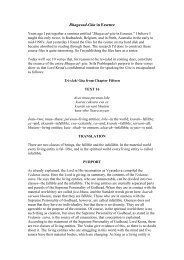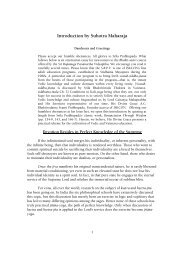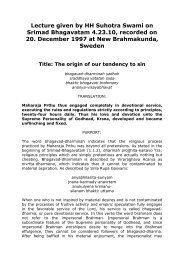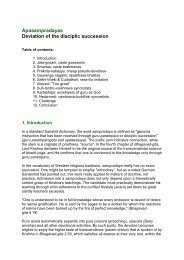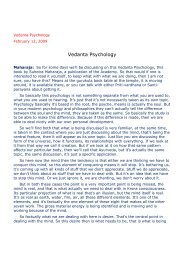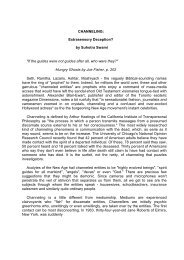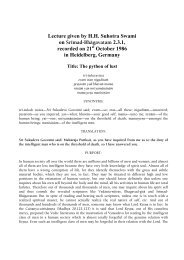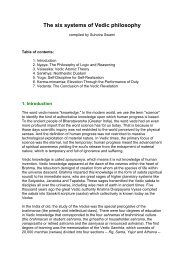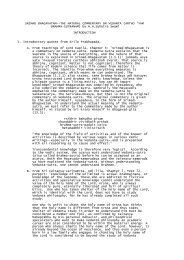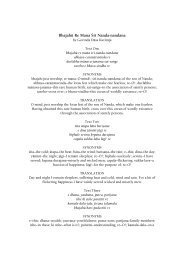What The Upanisads Teach.pdf - Suhotra Maharaja Archives
What The Upanisads Teach.pdf - Suhotra Maharaja Archives
What The Upanisads Teach.pdf - Suhotra Maharaja Archives
Create successful ePaper yourself
Turn your PDF publications into a flip-book with our unique Google optimized e-Paper software.
From Ramanujacarya's commentary on Vedanta-sutra (anandamaya-abhyasat) welearn that the jivatma is the sarira (body) of Paramatma. <strong>The</strong> vijanamaya self is thejiva, and the self of that self--the anandamaya self--is Paramatma.<strong>The</strong>re are passages in the <strong>Upanisads</strong> that assert nondifference between jivatma andParamatma. Chandogya VI. 8. 7 expresses a statement that Sankaracarya has takento be the maha-vakya (which means maha-mantra; see Cc Adi 7. 130) of all Vedantaliterature: tat tvam asi svetaketo--"Svetaketu, you are that [Brahman]. " FromBrhadaranyaka Upanisad comes another statement oft-quoted by Mayavadis: ahambrahmasmi (I am Brahman). <strong>The</strong> same upanisad declares idam sarvam yad ayamatma, "All this is atma. " Mandukya Upanisad asserts sarvam hy etad brahma ayamatma brahma: "All this is verily Brahman; this atma is Brahman. " Chandogyaequates the universe, and all the jivas in it, with Brahman: sarvam khalv idambrahma. Brahmaivedam visvam, says Mundakopanisad: "Brahman is verily theuniverse. " "<strong>The</strong> Purusa is everything," states Svetasvatara Upanisad (purusa evaidam sarvam).In his purport to Srimad-Bhagavatam 4. 28. 63, Srila Prabhupada nicely sums up theVaisnava understanding of these "nondifference" statements of the Vedic literature.Vaisnava philosophers conclude that the living entity is simply a small sample of theoriginal Supreme Personality of Godhead. Qualitatively, God and the living entitiesare one, but quantitatively the living entities are small fragments of the SupremePersonality of Godhead. <strong>The</strong> Supreme Lord is full, powerful and opulent. In theprevious verse, the Lord says, "My dear friend, you and I are not different. " Thisnondifference refers to qualitative oneness, for it was not necessary for theParamatma, the Supreme personality, to remind the conditioned soul that he is notone in quantity. <strong>The</strong> self-realized soul never thinks that he and the SupremePersonality of Godhead are one in every respect. Although he and the SupremePersonality of Godhead are one in quality, the living entity is prone to forget hisspiritual identity, whereas the Supreme Personality never forgets. This is thedifference between lipta and alipta. <strong>The</strong> Supreme Personality of Godhead is eternallyalipta, uncontaminated by the external energy. <strong>The</strong> conditioned soul, however, beingin contact with material nature, forgets his real identity; therefore when he seeshimself in the conditioned state, he identifies himself with the body.It its fullest understanding, the nondifference between atma and Paramatma is of thenature of intimate, inseparable personal relationship, not of impersonal monism. Ashas been noted in this series several times, Mayavadis suppose BrhadaranyakaUpanisad to represent the purest account of impersonal monism to be found in anyof the <strong>Upanisads</strong>. Yet in III. 7. 32 of that upanisad we find:ya atmani tisthan atmanah antarahyam atma na veda yasya atma sariramyo atmanam antaro yamayati sa tatava atma antaryami amrtahHe who dwells in the atman [the individual self], yet is within [inside and still distinctfrom] that self, whom that self does not know, whose body is that self, who controlsthat self from within, he is your Self [the Self of your self], the Inner Controller, theImmortal.23



